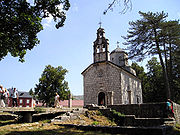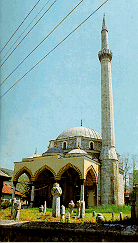
Religion in Montenegro
Encyclopedia

Montenegro
Montenegro Montenegrin: Crna Gora Црна Гора , meaning "Black Mountain") is a country located in Southeastern Europe. It has a coast on the Adriatic Sea to the south-west and is bordered by Croatia to the west, Bosnia and Herzegovina to the northwest, Serbia to the northeast and Albania to the...
is a multireligious country. Although Orthodox Christianity
Eastern Orthodox Church
The Orthodox Church, officially called the Orthodox Catholic Church and commonly referred to as the Eastern Orthodox Church, is the second largest Christian denomination in the world, with an estimated 300 million adherents mainly in the countries of Belarus, Bulgaria, Cyprus, Georgia, Greece,...
is the dominant religion, there are also sizable adherents of Islam
Islam
Islam . The most common are and . : Arabic pronunciation varies regionally. The first vowel ranges from ~~. The second vowel ranges from ~~~...
and Catholic Christianity. The dominant Church is the Serbian Orthodox Church
Serbian Orthodox Church
The Serbian Orthodox Church is one of the autocephalous Orthodox Christian churches, ranking sixth in order of seniority after Constantinople, Alexandria, Antioch, Jerusalem, and Russia...
- although traces of a forming Montenegrin Orthodox Church
Montenegrin Orthodox Church
The Montenegrin Orthodox Church is an Orthodox Christian organization acting in Montenegro and Montenegrin emigration circles - e.g. the village of Lovćenac and the Montenegrin emigration colony in Argentina...
are present.
2003 census
According to 2003 census, major religious groups in Montenegro were- Orthodox Christians - 460,383 (74.24%)
- Sunni Muslims - 110,034 (17.74%)
- Roman Catholic Christians - 21,972 (3.54%)
No other religious group in Montenegro, including Protestant Christians and Jews
Jews
The Jews , also known as the Jewish people, are a nation and ethnoreligious group originating in the Israelites or Hebrews of the Ancient Near East. The Jewish ethnicity, nationality, and religion are strongly interrelated, as Judaism is the traditional faith of the Jewish nation...
, reaches 1%.
Orthodox Christianity
Orthodox Christianity is the dominant religion in Montenegro. Adherents of Orthodox Christianity in Montenegro are predominantly Montenegrins and SerbsSerbs
The Serbs are a South Slavic ethnic group of the Balkans and southern Central Europe. Serbs are located mainly in Serbia, Montenegro and Bosnia and Herzegovina, and form a sizable minority in Croatia, the Republic of Macedonia and Slovenia. Likewise, Serbs are an officially recognized minority in...
. While the Serbs are adherents of the Serbian Orthodox Church
Serbian Orthodox Church
The Serbian Orthodox Church is one of the autocephalous Orthodox Christian churches, ranking sixth in order of seniority after Constantinople, Alexandria, Antioch, Jerusalem, and Russia...
and its diocese in Montenegro, the Metropolitanate of Montenegro and the Littoral, Montenegrins are divided between the Serbian Orthodox Church and the Montenegrin Orthodox Church
Montenegrin Orthodox Church
The Montenegrin Orthodox Church is an Orthodox Christian organization acting in Montenegro and Montenegrin emigration circles - e.g. the village of Lovćenac and the Montenegrin emigration colony in Argentina...
(which is still in its phase of conceivement and is non-canonical and unrecognized).
The identity of Montenegrins and Serbs in Montenegro is largely based on Orthodox Christianity.
Islam

Slavic Muslims
Slavic Muslims are ethnic groups or sub-ethnic groups of Slavs who observe the Islamic faith, such as:* Bosniaks * Gorani * Pomaks * Torbeš See also: Muslims by nationality...
(split among Bosnian
Bosnian language
Bosnian is a South Slavic language, spoken by Bosniaks. As a standardized form of the Shtokavian dialect, it is one of the three official languages of Bosnia and Herzegovina....
-speaking Bosniaks
Bosniaks
The Bosniaks or Bosniacs are a South Slavic ethnic group, living mainly in Bosnia and Herzegovina, with a smaller minority also present in other lands of the Balkan Peninsula especially in Serbia, Montenegro and Croatia...
, Slavic Muslims
Muslims by nationality
Muslims by nationality was a term used in Socialist Federal Republic of Yugoslavia as an official designation of nationality of Slavic Muslims. They were one of the constitutive groups of Bosnia and Herzegovina...
, Montenegrin
Montenegrin language
Montenegrin is a name used for the Serbo-Croatian language as spoken by Montenegrins; it also refers to an incipient standardized form of the Shtokavian dialect of Serbo-Croatian used as the official language of Montenegro...
-speaking Muslim Montenegrins), and ethnic Albanians
Albanians
Albanians are a nation and ethnic group native to Albania and neighbouring countries. They speak the Albanian language. More than half of all Albanians live in Albania and Kosovo...
. Islam is the dominant religion in the northeastern municipalities, which are part of the Sandžak
Sandžak
Sandžak also known as Raška is a historical region lying along the border between Serbia and Montenegro...
geographical region, and in municipalities where Albanians form a majority. Islam is the majority religion in Plav
Plav
Plav Plav Plav (Montenegrin, (Albanian: Plav) is a town in north-eastern Montenegro. It has a population of 3,615 (2003 census).Plav is the centre of the municipality (population of 13,805),-Geography:...
, Rožaje
Rožaje
Rožaje , is a town in northeastern Montenegro. It has a population of 9,121 Rožaje is the centre of the municipality, which has a population of 22,693. The municipality is located in the geographical region of Sandžak.-History:The history of Rožaje goes back to 1571 and 1585 when it was first...
and Ulcinj
Ulcinj
Ulcinj is a coastal resort town and municipality in Montenegro. The town of Ulcinj has a population of 10,828 of which the majority are Albanians...
.
Roman Catholic and Eastern Rite Catholic communities
Catholic Christianity is mostly present in the region of Boka Kotorska, where there is a significant presence of ethnic CroatsCroats
Croats are a South Slavic ethnic group mostly living in Croatia, Bosnia and Herzegovina and nearby countries. There are around 4 million Croats living inside Croatia and up to 4.5 million throughout the rest of the world. Responding to political, social and economic pressure, many Croats have...
. Also, a number of ethnic Albanians
Albanians
Albanians are a nation and ethnic group native to Albania and neighbouring countries. They speak the Albanian language. More than half of all Albanians live in Albania and Kosovo...
are adherents of Catholic Christianity.
According to CNEWA Canada Catholics of the Byzantine Rite
Byzantine Rite
The Byzantine Rite, sometimes called the Rite of Constantinople or Constantinopolitan Rite is the liturgical rite used currently by all the Eastern Orthodox Churches, by the Greek Catholic Churches , and by the Protestant Ukrainian Lutheran Church...
number over 20 000 persons in the regions of Montenegro and Serbia:
In 2003 an Apostolic Exarchate was created for Greek Catholics in Serbia and Montenegro, headed by Bishop Djura Džudžar (born 1954, appointed 2003). It has 21 parishes and 22,720 faithful, consisting mostly of a group of ethnic Rusyn Greek Catholics in the region of Vojvodina.http://www.cnewacanada.ca/ecc-bodypg-ca.aspx?eccpageID=73&IndexView=toc
See also
- Islam in MontenegroIslam in MontenegroMuslims in Montenegro form the largest minority religion in the country. According to the 2011 census, Montenegro's 118,477 Muslims make up c. 19.1% of the total population. They are divided into these main groups: Slavic Muslims split among Bosnian-speaking Bosniaks, Slavic Muslims,...
- History of the Jews in MontenegroHistory of the Jews in MontenegroThere is no organized Jewish community in Montenegro. The 2007 Montenegrin Statistical Yearbook lists 12 Jews in the country, spread across nine towns. There is little evidence of a significant historic Jewish presence in the country.-References:...
- Religion by country
- Roman Catholicism in MontenegroRoman Catholicism in MontenegroThe Catholic Church in Montenegro is a part of the worldwide Catholic Church, under the spiritual leadership of the Pope and Curia in Rome. There are 21, 299 Catholics in Montenegro, and they form three and a half percent of the population...
External links
- www.monteislam.com
- Islamic Community in Montenegro
- Protestant Mission to Montenegro
- Demographics of MontenegroDemographics of MontenegroThis article is about the demographic features of the population of Montenegro, including population density, ethnicity, education level, health of the populace, economic status, religious affiliations and other aspects of the population.- Total population:...

